Painted furniture ideas and inspiration
Advices
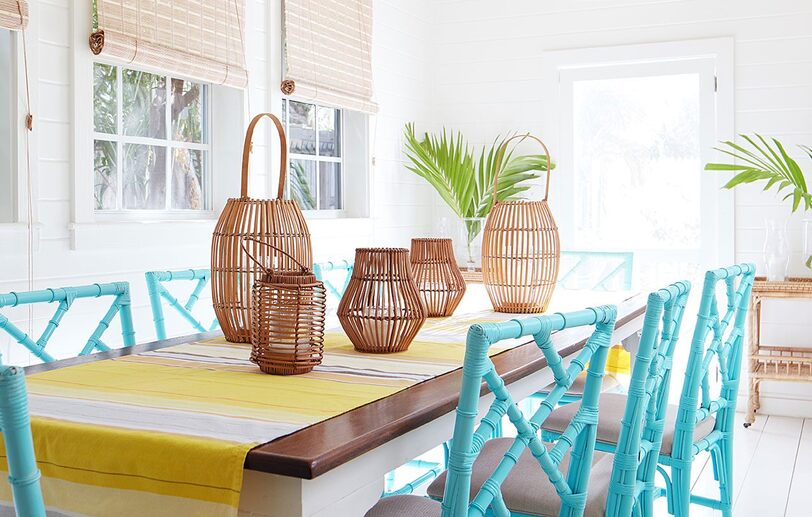
Painting furniture is a cost-effective and fun way to bring impact to a room without too much effort. Use a solid coat of vivid, bold paint color to turn any furnishing from wall flower to a center stage conversation piece.
Whether it’s an old chair, stool, side table, dresser or decorative item like a large mirror frame, a fresh coat of paint adds a refreshing swath of color—without undertaking a full room transformation.
Your DIY Guide to Update Second-Hand Furniture
In an appearance on Cityline, a popular Canadian daytime show featuring home decor and lifestyle tips, Benjamin Moore Color & Design expert Sharon Grech demonstrates how to transform flea market finds.
"We often need go no further than ‘shopping’ our own homes for the perfect old piece that is ripe for upcycling. So, before you bring it to the curbside, give it a second look and imagine it painted in your favorite color."
Sharon Grech, Color & Design Expert
Painting Furniture: Where to Start
Start with assessing the type of furniture you’re painting and the space it will live in. What is your design style? Do you want to make a strong statement? Or simply give a well-loved piece of furniture a subtle update? Whether you have sleek laminate pieces or treasured antique ones, a fresh coat of paint is transformative.
Pay attention to pieces with solid construction and interesting silhouettes or lines, like these quirky high-back chairs, painted with eye-catching Coral Gables 2010-40. Knowing what vibe you’re going for will help you choose the right color and make your painting project a success.
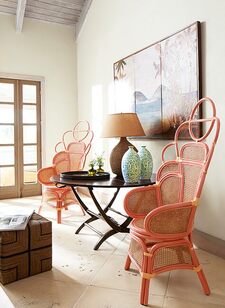
Choosing Your Furniture Paint Color
With thousands of paint colors to choose from, how do you select the best color for painted furniture?
“Look to other items in the room or in open, adjacent rooms for inspiration,” says Sharon. “Artwork and textiles are great sources of color inspiration as they often have several hues woven in. On the other hand, painted furniture can become a work of art, so consider this an opportunity to select a fun palette of colors that you might not feel comfortable with on the walls.”
This bedroom, in crisp Paper White OC-55, offers an unexpected pop of color with Cedar Green 2034-40 on the headboard, a stroke of vibrancy in an otherwise quiet space.
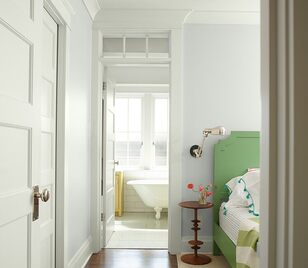
Lighting, Sheen and Painted Furniture
No matter where your painted furniture will live, the amount of light it gets throughout the day is an important factor in choosing the perfect color.
“Lighting plays a crucial role in color perception,” Sharon says, “so viewing your options in the correct lighting condition will help avoid unwanted color surprises.” Test out your options with an 8 oz. color sample, available online or at your local store.
Consider your choice of sheen as well, especially when painting older furniture. Lower sheens are often selected for vintage pieces because they help mask blemishes and reflect a piece’s old-world charm. Higher sheens tend to accentuate imperfections, and are therefore more appropriate for smooth surfaces that command a shiny, lacquered look.
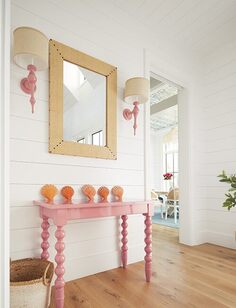
The Best Product for Painted Furniture
When it comes to the best paint for furniture, go with a product that delivers a durable, straight-from-the-factory finish. ADVANCE® Interior provides outstanding coverage and hide, and is great for camouflaging minor imperfections. Easy to apply and easy to clean, the result is a high-end, furniture-like finish.
The premium quality and performance of ADVANCE makes it the ideal paint for wood or laminate furniture. For more specialized projects, like painting wicker or metal furniture, consult with a locally owned Benjamin Moore retailer, and check out our list of “how-to” articles below.

The Charm of Upcycled Furniture
There’s something inspiring about an older piece of furniture made new again: With a fresh coat of paint, you can make it entirely your own. From estate and thrift store finds to that saved-from-the-landfill gem found curbside, repainted furniture is an easy way to explore self-expression.
“Whether it’s updating the cabinets in your powder room or home office or breathing new life into an old China cabinet, why not take a cue from some of the statement colors in home fashion today and be more daring?” asks Sharon.
“Try painting the back panel of a display cabinet or the inside of a drawer with your favorite bold color and see how it’s instantly transformed.”
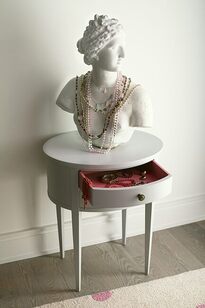
Frequently Asked Questions
Q. Do I have to prime furniture before painting it?
A. It depends on the type of surface you are painting and whether it has been painted before. INSL-X® Stix® Waterborne Bonding Primer is a good primer for most challenging surfaces, including nonporous ones such as Formica®, laminate, glossy tile and more. Always prime any surface that has not been previously painted: Try Fresh Start® High-Hiding All-Purpose Primer 046, a high performing primer for most interior and exterior surfaces. After priming, you are ready to paint your indoor furniture.
Q. How to paint wood furniture?
A. Wood furniture needs to be clean, dry and ready to accept paint. After cleaning and possibly sanding, apply one coat of Fresh Start® High-Hiding All-Purpose Primer 046, a high performing primer that works for most interior and exterior surfaces. Fresh Start is also great for drastic paint color changes. For paint, we recommend Advance® Interior paint for its hard, high-end finish, although any Benjamin Moore interior premium paint will look beautiful, including Regal® or AURA®. Ready to learn more? Check out refinishing wood furniture and tips on painting and staining outdoor wood furniture.
Q. Can you paint wicker furniture?
A. Yes, you can. Start by thoroughly cleaning the wicker prior to painting. This might require brushing and/or vacuuming to collect any debris that has gathered between the woven surface. If you try washing the furniture, be careful to delicately dry it thoroughly. From there, prime the surface and let it dry completely. We recommend spraying wicker furniture over using a paint brush—ask your local Benjamin Moore retailer about a hand-held sprayer. Try Advance® Interior paint to spray-paint wicker, a favorite for its durable, high-end finish.
Q. How long should paint dry before putting furniture back?
A. Always follow the dry-time instructions on the paint can. Remember: Thicker coats take longer to dry. The environment will impact dry-time; for example, higher humidity means slower dry-time. While two hours is the average, some projects might take more or less time to dry.